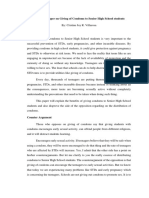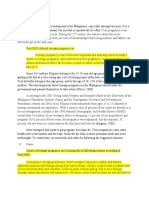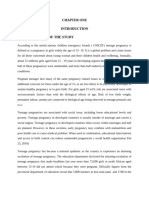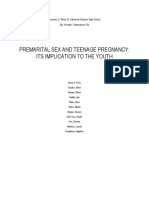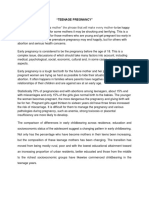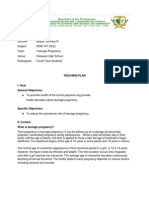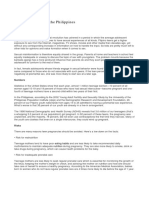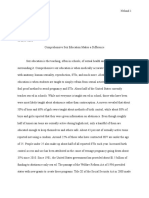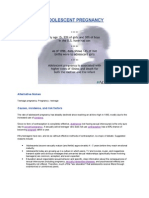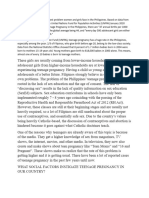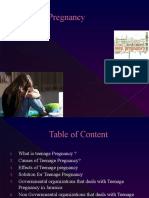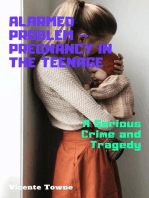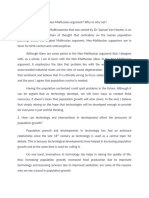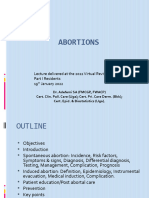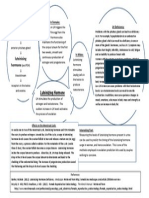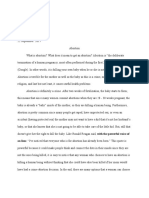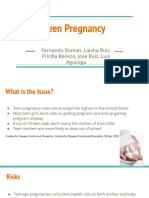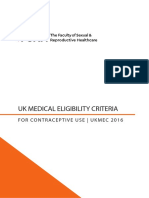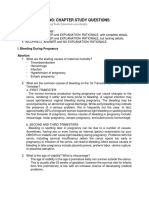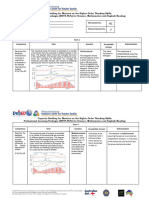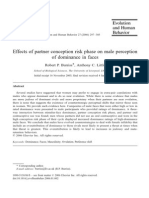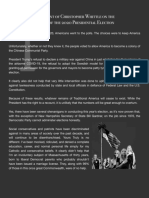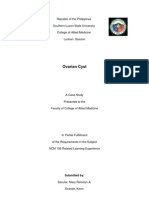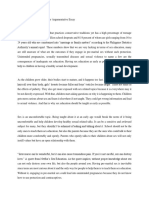0 ratings0% found this document useful (0 votes)
105 viewsPerformance Task in Health
Performance Task in Health
Uploaded by
Joshua Emmanuel Ledesma1) Teenage pregnancy is a significant issue in the Philippines, with over 10 million adolescent girls aged 10-19. Early pregnancy can have negative health impacts for both mother and child.
2) Common causes of teenage pregnancy include lack of sexual education and access to family planning services, as well as social and family pressures. Starting antenatal care early can help address these issues.
3) Abstinence and contraceptive use are effective ways to prevent teenage pregnancy and STDs. It is important for sexually active youth to use condoms correctly and consistently with each sexual encounter. Comprehensive sexual education can help empower young people to make informed choices.
Copyright:
© All Rights Reserved
Available Formats
Download as PPTX, PDF, TXT or read online from Scribd
Performance Task in Health
Performance Task in Health
Uploaded by
Joshua Emmanuel Ledesma0 ratings0% found this document useful (0 votes)
105 views9 pages1) Teenage pregnancy is a significant issue in the Philippines, with over 10 million adolescent girls aged 10-19. Early pregnancy can have negative health impacts for both mother and child.
2) Common causes of teenage pregnancy include lack of sexual education and access to family planning services, as well as social and family pressures. Starting antenatal care early can help address these issues.
3) Abstinence and contraceptive use are effective ways to prevent teenage pregnancy and STDs. It is important for sexually active youth to use condoms correctly and consistently with each sexual encounter. Comprehensive sexual education can help empower young people to make informed choices.
Copyright
© © All Rights Reserved
Available Formats
PPTX, PDF, TXT or read online from Scribd
Share this document
Did you find this document useful?
Is this content inappropriate?
1) Teenage pregnancy is a significant issue in the Philippines, with over 10 million adolescent girls aged 10-19. Early pregnancy can have negative health impacts for both mother and child.
2) Common causes of teenage pregnancy include lack of sexual education and access to family planning services, as well as social and family pressures. Starting antenatal care early can help address these issues.
3) Abstinence and contraceptive use are effective ways to prevent teenage pregnancy and STDs. It is important for sexually active youth to use condoms correctly and consistently with each sexual encounter. Comprehensive sexual education can help empower young people to make informed choices.
Copyright:
© All Rights Reserved
Available Formats
Download as PPTX, PDF, TXT or read online from Scribd
Download as pptx, pdf, or txt
0 ratings0% found this document useful (0 votes)
105 views9 pagesPerformance Task in Health
Performance Task in Health
Uploaded by
Joshua Emmanuel Ledesma1) Teenage pregnancy is a significant issue in the Philippines, with over 10 million adolescent girls aged 10-19. Early pregnancy can have negative health impacts for both mother and child.
2) Common causes of teenage pregnancy include lack of sexual education and access to family planning services, as well as social and family pressures. Starting antenatal care early can help address these issues.
3) Abstinence and contraceptive use are effective ways to prevent teenage pregnancy and STDs. It is important for sexually active youth to use condoms correctly and consistently with each sexual encounter. Comprehensive sexual education can help empower young people to make informed choices.
Copyright:
© All Rights Reserved
Available Formats
Download as PPTX, PDF, TXT or read online from Scribd
Download as pptx, pdf, or txt
You are on page 1of 9
PERFORMANCE TASK IN HEALTH
TEENAGE PREGNANCY
SUBMITTED BY: JOSHUA EMMANUEL LEDESMA
SUBMITTED TO: MME. FLORDELIZA HURBODA
TEENAGE PREGNANCY
IN THE PHILIPPINES
The Philippines’ population will reach 108.8 million in 2020, according to the
Philippine Statistics Authority (PSA) estimate. More than 53 million are below 25
years of age, including 10.3 million adolescent girls (10-19 years old). Countries
with a “demographic window of opportunity” and large shares of young people,
such as the Philippines, have an opportunity to accelerate development if
strategic investments are made. This is a phenomenon known as the
“demographic dividend” which is discussed in Chapter 13 of the Philippines
Development Plan 2017-2022. This is exactly how countries like Japan achieved
economic growth – by reaping a demographic dividend by investing in health,
education, and employability of young people. Looking back in the 1970s, the
Philippines, Thailand, and Republic of Korea (South Korea) shared almost a
similar population – South Korea 32 million, Thailand 37 million, and the
Philippines 36 million. 50 years later in 2020, South Korea’s population has
increased by 59% to 51 million, Thailand by 189% to 70 million, and the
Philippines by 304% to 109 million. The ranking of GNI per capita of these
countries is the opposite to the population growth, with South Korea the highest
at 30,600 USD, Thailand at 6,610 USD and the Philippines at 3,830 USD,
according to the World Bank.
CAUSE OF TEENAGE PREGNANCY
Lack of information about sexual and
reproductive health and rights
Inadequate access to services tailored to
young people
Family, community and social pressure to
marry
Sexual violence
Child, early and forced marriage, which can
be both a cause and a consequence
Lack of education or dropping out of school
EFFECTS OF TEENAGE PREGNANCY
Results
The adjusted odds of becoming pregnant between ages 14 and 19 for teens with
at least one older sister having a teenage pregnancy were 3.38 (99 % CI 2.77–
4.13) times higher than for women whose older sister(s) did not have a teenage
pregnancy. Teenage daughters of mothers who had their first child before age
20 had 1.57 (99 % CI 1.30–1.89) times higher odds of pregnancy than those
whose mothers had their first child after age 19. Educational achievement was
adjusted for in a sub-population examining the odds of pregnancy between ages
16 and 19. After this adjustment, the odds of teenage pregnancy for teens with
at least one older sister who had a teenage pregnancy were reduced to 2.48
(99 % CI 2.01–3.06) and the odds of pregnancy for teen daughters of teenage
mothers were reduced to 1.39 (99 % CI 1.15–1.68).
Conclusion
Although both were significant, the relationship between an older sister’s
teenage pregnancy and a younger sister’s teenage pregnancy is much stronger
than that between a mother’s teenage childbearing and a younger daughter’s
teenage pregnancy. This study contributes to understanding of the broader topic
“who is influential about what” within the family.
HOW TO PREVENT TEENAGE
PREGNANCY
How can teenage pregnancy be prevented?
Abstinence
This is when a person decides not to have sex until they are married.
Some think this is old-fashioned, others think it is morally the best thing to do. Don’t worry what other’s
think - what do you think?
Delaying Sex
Many people feel that they don’t want to wait until marriage before having sex.
At the same time they don’t want to rush into it and make costly mistakes. So they decide to delay
having sex until they are older, more responsible, in a stable relationship with one partner, have a job, or
have become independent of their parents.
Does this sound reasonable to you?
If you choose either abstinence or delaying sex, there are some further steps that will help to protect
you:
Choose you friends carefully. Friends should want what is best for you, and they should respect your
decision not to have sex. Beware of friends who try and pressure you into having sex.
Beware of situations, like a group of friends drinking or taking drugs that could lead to unsafe sex.
Beware of partners who claim ‘You must sleep with me to prove you love me.’
Listen and learn from those who have gone through teenage pregnancy. They know the mistakes and
disadvantages, and can help you to avoid making the same mistakes.
Listen and learn from your parents about their life experiences. If they put restrictions on you, it is not
necessarily because they want to make you suffer. Usually, it is because they want the best for you, so
they do it to help and protect you.
If you decide that abstinence and delay sex are not the best decisions
for you, and you’d rather not wait before having sex, then you should
take time and effort to learn about the best means of protection:
Contraception
Contraception simply means using a method (mechanical or chemical)
to prevent pregnancy. There are various contraceptives that work in
different ways, but they are all designed to prevent pregnancy. Even if
you wish to practice abstinence of delay sex, it’s important to learn as
much as you can about contraception – knowledge is power.
Know your HIV status
What can I do if I’m pregnant?
Take someone you trust with you and visit the Clinic to start antenatal care at
8 weeks (2 months) of pregnancy [rather – "miss one period and go to your
nearest clinic and check if you are pregnant or not" and start ANC] Why is this
necessary?
Benefits of starting Antenatal care early
Receive knowledge about pregnancy and HIV
Voluntary counseling and HIV testing
Health care worker will assist in developing a plan that is suitable for you and
your baby during antenatal, delivery and postnatal and you have to put this
plan into practice as soon a you can.
Prevention mother to Chld Transmission (PMTCT) is available for all HIV
positive pregnant women.
Eat healthy nutritious food, exercise, and get plenty of sleep.
Avoid drugs and alcohol
Prevent further sexually transmitted infections (STI’S, HIV) during Pregnancy
Practice safe sex, use a condom
Infant feeding counselling
WHY TEENAGE PREGNANCY IS A
PROBLEM
Early pregnancies among adolescents have major health consequences
for adolescent mothers and their babies. Pregnancy and childbirth
complications are the leading cause of death among girls aged 15–19
years globally, with low- and middle-income countries accounting for
99% of global maternal deaths of women aged 15–49 years. 3 Adolescent
mothers aged 10–19 years face higher risks of eclampsia, puerperal
endometritis and systemic infections than women aged 20–24
years. 4 Additionally, some 3.9 million unsafe abortions among girls
aged 15–19 years occur each year, contributing to maternal mortality,
morbidity and lasting health problems. 1
Early childbearing can increase risks for newborns as well as young
mothers. Babies born to mothers under 20 years of age face higher
risks of low birth weight, preterm delivery and severe neonatal
conditions.4 In some settings, rapid repeat pregnancy is a concern for
young mothers, as it presents further health risks for both the mother
and the child.17
HOW TO PREVENT SDT,HIV AND
OTHER SEXUALLY TRANSMITTED
INFECTIONS
What can I do to prevent getting STDs and HIV?
The only 100% effective way to avoid STDs is to not have vaginal, anal, or
oral sex. If you are sexually active, you can do the following things to
lower your chances of getting STDs and HIV:
Choose less risky sex activities;
Use a new condom, consistently and correctly, for every act of vaginal,
anal, and oral sex throughout the entire sex act (from start to finish);
Reduce the number of people with whom you have sex;
Limit or eliminate drug and alcohol use before and during sex;
Have an honest and open talk with your healthcare provider and ask
whether you should be tested for STDs and HIV;
Talk to your healthcare provider and find out if either
pre-exposure prophylaxis, or PrEP, or post-exposure prophylaxis, or PEP,
is a good option for you to prevent HIV infection.
You might also like
- A Position Paper On Giving of Condoms To Senior High School StudentsDocument3 pagesA Position Paper On Giving of Condoms To Senior High School StudentsCristine Joy Remerata Villarosa89% (27)
- Research Essay Riley Henning 2Document12 pagesResearch Essay Riley Henning 2api-509444264No ratings yet
- BSM Bohol Research EditedDocument78 pagesBSM Bohol Research EditedBal Ri MekoleuNo ratings yet
- Preventing Early Pregnancy BriefDocument8 pagesPreventing Early Pregnancy BriefGansar Budi SantosoNo ratings yet
- Chapter IDocument38 pagesChapter ILouresa Mae TNo ratings yet
- Adolescent Pregnacy, Unwed Mother, Sexual Violence - 3rd BSC 2014Document236 pagesAdolescent Pregnacy, Unwed Mother, Sexual Violence - 3rd BSC 2014sindhujojo0% (1)
- Teenage Pregnancies in The Philippines 2Document5 pagesTeenage Pregnancies in The Philippines 2Tweetie Sabado83% (29)
- Sarmila RaiDocument9 pagesSarmila Raiapi-445368155No ratings yet
- Final ResDocument7 pagesFinal Resapi-379623062No ratings yet
- Teen Pregnancy-3Document8 pagesTeen Pregnancy-3api-341434718No ratings yet
- Teenage Pregnancy Is Not A BlessingDocument15 pagesTeenage Pregnancy Is Not A BlessingEryll Eunice VillaganasNo ratings yet
- A Teenage Pregnancy AwarenessDocument5 pagesA Teenage Pregnancy AwarenessgessNo ratings yet
- Louise!!!Document5 pagesLouise!!!Marielle Louise ArgarinNo ratings yet
- A Study On The Problem of Teenage PregnancyDocument37 pagesA Study On The Problem of Teenage PregnancyujranchamanNo ratings yet
- TARALADocument35 pagesTARALAMeynard MagsinoNo ratings yet
- TEENAGE PREGNAN-WPS OfficeDocument13 pagesTEENAGE PREGNAN-WPS OfficeTemitope AkinyeleNo ratings yet
- Gimba ShilatuDocument13 pagesGimba Shilatustephenemmanuel2347No ratings yet
- Chapter2The Cause and e-WPS OfficeDocument9 pagesChapter2The Cause and e-WPS OfficeJomer TamayoNo ratings yet
- Communication Plan (Djalene Toledo)Document9 pagesCommunication Plan (Djalene Toledo)Djalene ToledoNo ratings yet
- Chapter 1Document4 pagesChapter 1Faisal Tuazon IINo ratings yet
- Teenage PregnancyDocument5 pagesTeenage PregnancyDavid VenturaNo ratings yet
- Premarital Sex and Teenage PregnancyDocument4 pagesPremarital Sex and Teenage PregnancyjenniekimNo ratings yet
- Teenage PregnancyDocument3 pagesTeenage Pregnancyliezel napoles100% (1)
- Teen Pregnancies in The PhilippinesDocument7 pagesTeen Pregnancies in The PhilippinesJennevy Buque50% (2)
- English Research - Group6Document9 pagesEnglish Research - Group6Aezen HanamiyaNo ratings yet
- Teen Pregnancies in The PhilippinesDocument3 pagesTeen Pregnancies in The PhilippinesMarc Darwin RagojosNo ratings yet
- Notes of Sexual & Adolescent Reproductive Health From Lecturer, Year 4 Upgrading, 2019-2020Document35 pagesNotes of Sexual & Adolescent Reproductive Health From Lecturer, Year 4 Upgrading, 2019-2020SONGA AmriNo ratings yet
- Aaa SN PsycDocument2 pagesAaa SN Psyckingawesome21No ratings yet
- Exposee Danglais en-USDocument12 pagesExposee Danglais en-USSilveur TekkenNo ratings yet
- English - Research ReportDocument4 pagesEnglish - Research Reportxia wohjsNo ratings yet
- Teen Pregnancies in The PhilippinesDocument3 pagesTeen Pregnancies in The PhilippinesmonicajoannebalajadiaNo ratings yet
- SpeechDocument3 pagesSpeechBoy Kakak Toki100% (1)
- Chloe Nelund - Writing Sample - Research PaperDocument8 pagesChloe Nelund - Writing Sample - Research Paperapi-638662567No ratings yet
- Teenage PregnancyDocument7 pagesTeenage PregnancyRuzzel Mae Saile CodillaNo ratings yet
- Adolescent Pregnancy: Alternative NamesDocument4 pagesAdolescent Pregnancy: Alternative NamesSheena Yen de Pano-PagdalianNo ratings yet
- Research Paper-CHAPTER IIDocument5 pagesResearch Paper-CHAPTER IIkcthon100% (2)
- Adolescent PregnancyDocument24 pagesAdolescent PregnancyKyler DarkNo ratings yet
- Sexual Education Multimedia PamphletDocument19 pagesSexual Education Multimedia Pamphletapi-565393622No ratings yet
- WHO RHR 14.08 EngDocument4 pagesWHO RHR 14.08 EngAkebu LubasiNo ratings yet
- Literature Review 1Document5 pagesLiterature Review 1api-550490262No ratings yet
- I.Teenage Pregnancy: It'S Effect On Educational Development of Students and Out-Of-School YouthDocument6 pagesI.Teenage Pregnancy: It'S Effect On Educational Development of Students and Out-Of-School YouthJM LopezNo ratings yet
- Teenage PregnancyDocument20 pagesTeenage PregnancyRaniel John Avila Sampiano100% (2)
- ClaimsDocument2 pagesClaimsGessy Anne EstreraNo ratings yet
- English - Argumentative EssayDocument3 pagesEnglish - Argumentative EssayRicci ChingNo ratings yet
- Open The Door To SafetyDocument11 pagesOpen The Door To SafetySheena Marie M. TarleNo ratings yet
- Chapter 2Document7 pagesChapter 2angeline_letran91% (11)
- Teenage Pregnancy in The PhilippinesDocument7 pagesTeenage Pregnancy in The PhilippinesJanine Marie CaprichosaNo ratings yet
- QUESTION: Does A Minor Have The Right To Request Contraception From A Doctor Without Parental Consent?Document5 pagesQUESTION: Does A Minor Have The Right To Request Contraception From A Doctor Without Parental Consent?api-302138606No ratings yet
- Thesis Statement For Teenage PregnancyDocument5 pagesThesis Statement For Teenage Pregnancytamikabrownjackson100% (2)
- Teenage Pregnancy Is The Biggest Problem Women and Girls Face in The PhilippinesDocument3 pagesTeenage Pregnancy Is The Biggest Problem Women and Girls Face in The PhilippinesVon VeraNo ratings yet
- Pregnancy AccountDocument16 pagesPregnancy AccountBeyonce BennettNo ratings yet
- Teenage Pregnancy: Kimberly B. NacionDocument19 pagesTeenage Pregnancy: Kimberly B. NacionKim Nacion100% (4)
- What Causes Teenage Pregnancy?Document2 pagesWhat Causes Teenage Pregnancy?Queen Ella BiscochoNo ratings yet
- Adolescent PregnancyDocument3 pagesAdolescent PregnancyjaphetnwapiNo ratings yet
- ProjectDocument6 pagesProjectVicxie Fae CupatanNo ratings yet
- Sex EducationDocument2 pagesSex EducationHuemer UyNo ratings yet
- Teenage Pregnancy Presentation1Document11 pagesTeenage Pregnancy Presentation1Roy D. DaguploNo ratings yet
- Teenage PregnancyDocument3 pagesTeenage PregnancyCherrylou Buday100% (1)
- Teenage PregnancyDocument2 pagesTeenage Pregnancyliah rie mendozaNo ratings yet
- Alarmed Problem – Pregnancy in The Teenage: A Serious Crime and TragedyFrom EverandAlarmed Problem – Pregnancy in The Teenage: A Serious Crime and TragedyNo ratings yet
- Discussion 5.1 Global DemographyDocument2 pagesDiscussion 5.1 Global Demographycls100% (2)
- ABORTIONS AND ITS MANAGEMENT - FinalDocument73 pagesABORTIONS AND ITS MANAGEMENT - FinalSamuel AdefemiNo ratings yet
- Moringa OleiferaDocument4 pagesMoringa Oleiferajap pagharionNo ratings yet
- LH Concept MapDocument1 pageLH Concept Mapsarahm1171No ratings yet
- The Reproductive System1Document19 pagesThe Reproductive System1Elijah Mae CubaNo ratings yet
- Anestrum in Cattle: © TANUVAS, 2011Document11 pagesAnestrum in Cattle: © TANUVAS, 2011Sanjay KumarNo ratings yet
- Knowledge On Preconception Care Among Reproductive Age WomenDocument6 pagesKnowledge On Preconception Care Among Reproductive Age WomenMegayanaYessyMarettaNo ratings yet
- English Presentation Love RosieDocument10 pagesEnglish Presentation Love RosieFourini Marethalia MokoNo ratings yet
- Secondary - Health 78 - Lesson 2 - Family PlanningDocument13 pagesSecondary - Health 78 - Lesson 2 - Family PlanningGiselle TapawanNo ratings yet
- SituationdDocument64 pagesSituationdIvory SantiagoNo ratings yet
- Abortion Persuasive EssayDocument5 pagesAbortion Persuasive EssayalexiaNo ratings yet
- Family Planning. Contraception.: Corina Cardaniuc Department of Obstetrics and GynecologyDocument67 pagesFamily Planning. Contraception.: Corina Cardaniuc Department of Obstetrics and GynecologyAlexandru PusneiNo ratings yet
- Schoolgirls Pregnancy in BeninDocument2 pagesSchoolgirls Pregnancy in BeninMichelNo ratings yet
- 7 - Pharmacology (BusySPR 2016 SBAs)Document118 pages7 - Pharmacology (BusySPR 2016 SBAs)KeeranmayeeishraNo ratings yet
- Teen PregnancyDocument11 pagesTeen Pregnancyapi-456588134No ratings yet
- Causes of Semen Abnormalities Abnormal CountDocument3 pagesCauses of Semen Abnormalities Abnormal Countspajda69No ratings yet
- Female Reproductive Anatomy - The Garden of FertilityDocument4 pagesFemale Reproductive Anatomy - The Garden of FertilityEva TuáNo ratings yet
- FSRH Ukmec Full Book 2017Document178 pagesFSRH Ukmec Full Book 2017A KNo ratings yet
- Physiologic Changes in Pregnancy: Thomas S. Ivester, MD, MPH Maternal-Fetal MedicineDocument39 pagesPhysiologic Changes in Pregnancy: Thomas S. Ivester, MD, MPH Maternal-Fetal MedicineDthird Mendoza ClaudioNo ratings yet
- Individual Activity #3: CHAPTER STUDY QUESTIONS: Rubric For Short AnswerDocument11 pagesIndividual Activity #3: CHAPTER STUDY QUESTIONS: Rubric For Short AnswerSatanichia McDowell KurumizawaNo ratings yet
- Management of Infertility: Presented By: Dr. Sheetal M Savaliya Guide: Dr. Anil P Singh Co-Guide: Dr. Shailesh MundhavaDocument37 pagesManagement of Infertility: Presented By: Dr. Sheetal M Savaliya Guide: Dr. Anil P Singh Co-Guide: Dr. Shailesh MundhavaBhawna JoshiNo ratings yet
- Worksheet-4C - TEAM ALPHADocument4 pagesWorksheet-4C - TEAM ALPHARina RomanoNo ratings yet
- Burriss 06 Maledom MensDocument9 pagesBurriss 06 Maledom MensGeorge BaciuNo ratings yet
- Statement of Christopher Whittle On The Result of The 2020 Presidential ElectionDocument3 pagesStatement of Christopher Whittle On The Result of The 2020 Presidential ElectionChrisWhittleNo ratings yet
- Ovarian Cyst FinalDocument26 pagesOvarian Cyst FinalReicy Aquino SacularNo ratings yet
- The Study of Factors Influencing Teenagers Pregnancy in AfricaDocument7 pagesThe Study of Factors Influencing Teenagers Pregnancy in AfricawindyNo ratings yet
- Anti Sex EducationDocument2 pagesAnti Sex EducationMartinNo ratings yet
- FGM, Right To Cultural Integrity, Right To HealthDocument2 pagesFGM, Right To Cultural Integrity, Right To Healthkimoymoy7No ratings yet
- Ob Gy1Document9 pagesOb Gy1Ahmad SobihNo ratings yet
- Igcse Biology ReproductionDocument92 pagesIgcse Biology ReproductionEric Chew100% (3)
